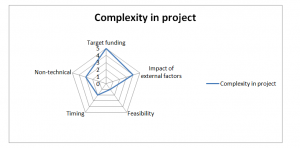PPMP20014 Analysis the Grand Ethiopian Renaissance Dam (GERD) project
The main purpose of this study is critically analysis the Grand Ethiopian Renaissance Dam (GERD) project for determining the complexity faced by the project.
The main purpose of this study is to classify the causes, environment and properties which developed the complexity in the project. In addition, this study will extract the different parameters (tools and techniques) for assessing the complexity aspects which is associated with GERD project.
In concern to it, this study will critically assess the complexity aspect by using the similar approaches so that level and types of complexity can be determined.
The determined level of complexity and different parameters will be used for formulating the radar diagram for conducting proper evaluation. At last, overall study will be evaluated and judged for determining what level of complexity actually faced under the GERD project.
In 2011, GERD involved in huge controversial project of Africa as there are different aspects that affected the project complexity to some extent. For analyzing the complexity of the GERD project, for that there is need to identify different parameters which are interlinked with the aspect of the completion of the project.
There are different parameters which are considered for analyzing the complexity aspect i.e., cost, scope, designing, politics, legislation and future risks and key project stakeholders and so on (Gransberg et al., 2012).
These all stated parameters helped in understanding and assessing the complex situation in project management which is faced by the project manager in managing the routine work process efficiently and effectively.
While analyzing the project, it is determined that there are different causes such as environment, physical displacement and public health and safety & security and so on which created huge positive and negative impact on the project growth and efficiency (Tesfa, 2013).
However, these all stated causes somewhere creates complex situation for the project in terms of completion of the project on time and that also created uncertainty condition.
In concern to this, complexity theory is used by the project manager for managing the complex situations of project management respectively (Dao et al., 2016). This complexity theory states that project complexity is determined by analyzing the interrelationship and feedback between the increase in number of ambiguity and uncertainty.
The use of this theory helps in identifying the external and internal factors which creates a complex project for the project manager. The use of theory helps in the understanding the environment where project is developing or growing respectively (Hammond, 2013).
Based on these parameters, the technique is used by the project manager for aiding the complexity of project and from that the technique used was Analytic Hierarchy Process (AHP) is selected under the multi criteria decision analysis for assessing the complexity of the project.
In support to this, Soliman et al. (2016) also stated that there are different tools which are used for assessing the complexity of the project i.e., Grand Ethiopian Renaissance Dam (GERD).
The use of project complexity assessment tool help in identifying and assessing the complexity of the project and tools identified are feasibility of project, design of project, scope of project, construction process, etc (Ahmed & Elsanabary, 2015).
While analyzing the project, it is also found that there are some non- technical consequences which were also faced by the project manager and that affect the feasibility of the project. In regards to it, it is also determined that watery scarcities, difficulty at construction sites are the non-technical consequences which affected the project operation in an adverse manner.
| S. NO. | Tools or parameters | Complexity in project |
| 1. | Target funding | 5 |
| 2. | Impact of external factors | 4 |
| 3. | Feasibility | 1 |
| 4. | Timing | 2 |
| 5. | Non-technical | 3 |

The above stated radar diagram and table clearly demonstrates those parameters which affect the growth and development of the project.
Through this graph, it can be determined easily that target funding for the project is major constraint which resultant into the complex project to huge extent. In a similar manner, impact of external factors also considered as consequence which affect the project complexity at a moderate level (Veilleux, 2013).
On the other side, feasibility is another assessing tool which helps in determining the impact or complexity of the project that reflect the efficiency of the project life cycle. Through this graph, it is also determined that there was high complexity in the project because of which non-technical consequences which is decreasing the water share in different countries near to Nile River.
On the other side, key project stakeholders are also factors which develop complexity in project by bringing the change in the demand or expectation from the project development or growth (Wheeler et al., 2016).
Through this study, it is understood that structural and non technical complexity are main project complexity which affects the which help in judging the factors and tools that influences the approach of assessing complexity to a extent.
However, causes, complexity theory, tools and technique helped in evaluating and assessing the feasibility and efficiency of the project and challenges which are faced by the project manager.
From the above study, it can also be concluded easily that cost, time are major constraint in every project management which develop complexity for the manager. For this project, complexity theory is used for analyzing the nature and degree of the complexity.
Through this analysis, it is identified that there is high level of complexity such as scope, cost, design and construction of the dam found to be in project of Grand Ethiopian Renaissance Dam (GERD) respectively as this help in assessing that project has faced huge impact from internal and external factors in both positive & negative manner.
Ahmed, A. T., & Elsanabary, M. H. (2015, March). Hydrological and environmental impacts of Grand Ethiopian Renaissance Dam on the Nile River. In Proceedings of the Eighteenth International Water Technology Conference, IWTC18, Sharm El Sheikh, Egypt (pp. 12-14).
Dao, B., Kermanshachi, S., Shane, J., & Anderson, S. (2016). Project complexity assessment and management tool. Procedia Engineering, 145, 491-496.
Gransberg, D. D., Shane, J. S., Strong, K., & del Puerto, C. L. (2012). Project complexity mapping in five dimensions for complex transportation projects. Journal of Management in Engineering, 29(4), 316-326.
Hammond, M. (2013, February). The Grand Ethiopian Renaissance Dam and the Blue Nile: implications for transboundary water governance. In Global Water Forum (Vol. 1307).
Soliman, G., Soussa, H., & El-Sayed, S. (2016). Assessment of Grand Ethiopian Renaissance Dam impacts using decision support system. IOSR Journal of Computer Engineering (IOSR-JCE) e-ISSN, 2278-0661.
Tesfa, B. (2013). Benefit of grand Ethiopian renaissance dam project (GERDP) for Sudan and Egypt. Retrieved From: http://eprints.hud.ac.uk/id/eprint/19305/1/Belachew_Tesfa_Articles_EIPSA_6_Dec_2013-Uni.pdf
Veilleux, J. C. (2013). The human security dimensions of dam development: the grand Ethiopian renaissance dam. Global Dialogue, 15(2), 1-15.
Wheeler, K. G., Basheer, M., Mekonnen, Z. T., Eltoum, S. O., Mersha, A., Abdo, G. M., … & Dadson, S. J. (2016). Cooperative filling approaches for the grand Ethiopian renaissance dam. Water international, 41(4), 611-634.


